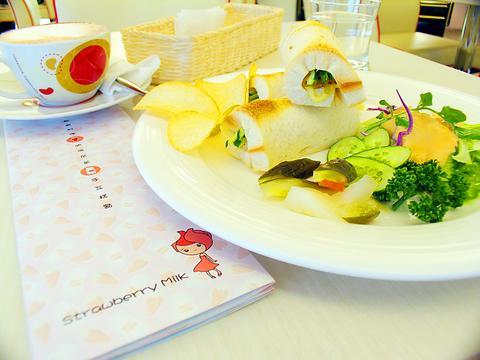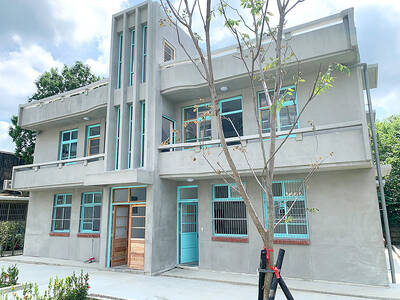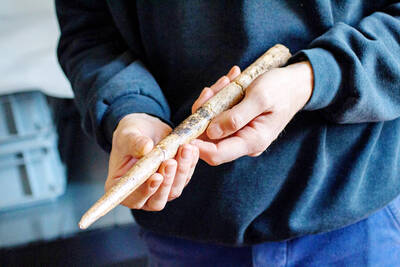If films like Steel Magnolias or the more recent Uptown Girls are said to be chick flicks, then Strawberry Milk is surely a chick restaurant. Located behind the Idee department store on Nanjing West Road, it is a pink-appointed parlor of cuteness -- and good sandwiches, coffees and teas -- that has become a mealtime Mecca for shoppers with sore feet.
Most people looking for a lunch spot in this shopping district are likely familiar with more popular places such as Melange, a miniscule cafe across the lane which sells gargantuan waffles, or Kan Pai, a Japanese grill which was one of the Taipei Times' top-10 restaurants last year. Strawberry Milk, which is upstairs from Kan Pai, seems to have been boosted by an overflow of people who grew tired of waiting in line for these other two places.

PHOTO: DAVID MOMPHARD, TAIPEI TIMES
The reason people keep coming back is obvious: There is no wait, there is a wider selection of food that tastes better than what Melange is serving and it's cheaper.
Like Melange, Strawberry Milk has waffles any time of day; butter waffles, sesame waffles and their signature strawberry waffle. They're lighter and tastier than Melange's and, unlike Melange, they're served in a comfortable smoke-free environment.
Strawberry Milk's fortes, however, are the dishes they've deemed "creative cuisine" -- a garlic spaghetti with sweet Taiwanese sausage diced in, a chilled halibut filet served with zesty pesto, or a sandwich that combines tuna, cheese and cucumbers on rolled-up slices of white bread. The whole thing is placed in the oven and baked so that the cheese melts, the bread toasts and the palette is pleased.
The place is named after a cartoon character. A short story on the back of the menu says that Strawberry Milk is 118cm tall, 25kg, with black eyes and red hair. She was born in Canada on the last day of the 20th century to bring smiles, good food and friendship to people everywhere, starting with Taiwan. She has a pet bear named Pipi and a boyfriend named Milk Pudding who fancies sailor suits. Images of the two are found throughout the restaurant and, in combination with the pink-and-white upholstery and strawberry-themed wallpaper, give the place the feel of an adult daycare center.
It's all very ke ai-o, but at least the coffee is strong. A selection of gourmet beans from places with exotic names is on offer, as are several delicious herbal teas, served hot or cold.
In a previous review in this space, I said that Melange is worth the wait. While that is still true, Strawberry Milk provides a good reason to not have to.

June 2 to June 8 Taiwan’s woodcutters believe that if they see even one speck of red in their cooked rice, no matter how small, an accident is going to happen. Peng Chin-tian (彭錦田) swears that this has proven to be true at every stop during his decades-long career in the logging industry. Along with mining, timber harvesting was once considered the most dangerous profession in Taiwan. Not only were mishaps common during all stages of processing, it was difficult to transport the injured to get medical treatment. Many died during the arduous journey. Peng recounts some of his accidents in

“Why does Taiwan identity decline?”a group of researchers lead by University of Nevada political scientist Austin Wang (王宏恩) asked in a recent paper. After all, it is not difficult to explain the rise in Taiwanese identity after the early 1990s. But no model predicted its decline during the 2016-2018 period, they say. After testing various alternative explanations, Wang et al argue that the fall-off in Taiwanese identity during that period is related to voter hedging based on the performance of the Democratic Progressive Party (DPP). Since the DPP is perceived as the guardian of Taiwan identity, when it performs well,

A short walk beneath the dense Amazon canopy, the forest abruptly opens up. Fallen logs are rotting, the trees grow sparser and the temperature rises in places sunlight hits the ground. This is what 24 years of severe drought looks like in the world’s largest rainforest. But this patch of degraded forest, about the size of a soccer field, is a scientific experiment. Launched in 2000 by Brazilian and British scientists, Esecaflor — short for “Forest Drought Study Project” in Portuguese — set out to simulate a future in which the changing climate could deplete the Amazon of rainfall. It is

Artifacts found at archeological sites in France and Spain along the Bay of Biscay shoreline show that humans have been crafting tools from whale bones since more than 20,000 years ago, illustrating anew the resourcefulness of prehistoric people. The tools, primarily hunting implements such as projectile points, were fashioned from the bones of at least five species of large whales, the researchers said. Bones from sperm whales were the most abundant, followed by fin whales, gray whales, right or bowhead whales — two species indistinguishable with the analytical method used in the study — and blue whales. With seafaring capabilities by humans